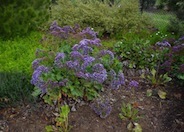
Common name:Sea Lavender, Statice
Botanical name:Limonium perezii
This mounding shrub will reach about 3' high and has large, dark green leaves with small blue and purple flowers that bloom in spring and summer.
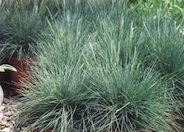
Common name:Elija Blue Fescue
Botanical name:Festuca glauca 'Elija Blue'
The 'Elijah Blue' is a dwarf, very glaucous variety with almost white foliage. It should receive sun and little summer watering. -Monterey Bay Nursrey
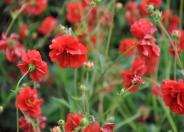
Common name:Geum
Botanical name:Geum sp.
The attractive perennial is grown for its brilliant red flowers found above foliage from spring through summer. Deadheading flowers encourages longer bloom period. Foliage is evergreen in mild winter climates and is lobed. This plant grows 12"-20" tall.
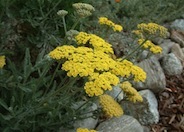
Common name:Allan Bloom Hybrd
Botanical name:Achillea X taygetaea 'Moonshine'
Long, straight stems with pale yellow flowers are apparent on the mats of green to grey-green leaves of this plant, which are flatter and less divided than those of the Achillea millefolium.
The yarrow propagate easily from rooted cuttings or division, which should be performed in the early spring or fall. Following bloom, one should dead head the plant and divide the clumps when it appears crowded.
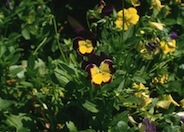
Common name:Johnny Jump Up
Botanical name:Viola tricolor
Viola tricolor grows 6-12 in. tall and broad. The flowers are combinations of velvety purple and yellow, or the orignial blue and yellow color.

Common name:Flowering Maple, Chinese Lantern
Botanical name:Abutilon hybrids
These evergreen shrubs usually grow to 8-10' tall and as wide. Most will tolerate frost to 25 degrees F or lower with some damage. All are irresistible to hummingbirds with their showy flowers and heavy nectar production. They will take sun to moderately deep shade and little or no summer watering in coastal areas. They should be given more shade and water in hotter, drier climates. They make an excellent plant for containers or hanging baskets. -Monterey Bay Nursery

Common name:Japanese Maple
Botanical name:Acer palmatum
This magnificent plant can used as a small tree or shrub. It is deciduous with graceful leaves which have a scarlet color in spring as it leafs out. They turn orange or yellow in fall. It is slow growing to 20', and requires shelter from hot winds.
The leaves of this tree are small, light green in color, and deply lobed. It should also be noted that the tree remains spectacular throughout all seasons. Second picture by Steve Mullany.
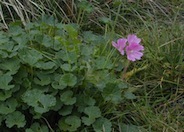
Common name:Checkerbloom
Botanical name:Sidalcea malviflora
This native perennial will grow about 2' tall and 2' wide. It has lobed, dark green leaves with pinkish purple flowers that bloom in early spring. Prefers limited water in summer; will come back with winter rains.
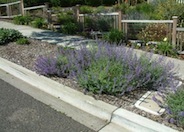
Common name:Catmint
Botanical name:Nepeta X faassenii
Nepeta faassenii makes soft, gray-green, undulating mounds o 1.5 ft. high in bloom. The small leaves are attractive to cats. This perennial has lavender blue flowers in late spring, and early summer.
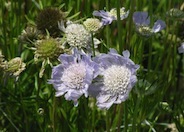
Common name:Pincushion Flower
Botanical name:Scabiosa caucasica
A perennial, cushion-form ground cover or bedding plant, growing 1 to 2 feet tall, 2-3 feet wide. White, bluish and lavender colored pom pom like flowers rise above the foliage.
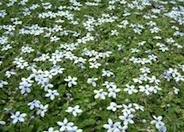
Common name:Blue Star Creeper, Isotoma
Botanical name:Pratia pedunculata
Laurentia fluviatilis has bright green, nearly stemless, 1/4" leaves. In late spring and summer, these form a backdrop for equally tiny, star-shaped pale blue flowers.
Sustainable landscaping is a term coined to mean sensible landscape practices that work within the limits of the Eco-system. This means within the limits of your local rainfall, soil conditions and sun patterns.
Click in the green box for more information
Designer: Unknown
Photographer: GardenSoft
Incorporate compost 6" into your soil to retain water, reduce compaction, feed earthworms, and provide valuable nutrients to your plants.
Mulching and adding compost to soil can minimize evaporation and help soil absorb and store water.
Develop healthy soil for plants that are vigorous and naturally pest-resistant.